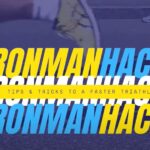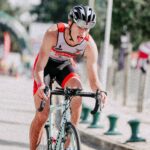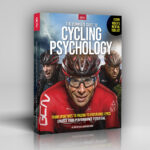Pain is an essential part of triathlon training and competition, and at the same time, the greatest obstacle triathletes face as they pursue their goals. Pain plays an important role in providing you with information about your triathlon, including your level of effort and the intensity of your training program. But pain is also a persistent and powerful physical warning to your body, often screaming at you to stop! Whether you use pain as an ally to achieve your triathlon goals or as an enemy to keep you from realizing your dreams depends on your understanding of pain and whether you can gain mastery over it.
Perspective on Pain
Using pain to your advantage starts with gaining a realistic perspective on what pain really is. A few weeks ago, I was out for a long, hilly (about 6000 vertical) ride with some friends. At the end of the six-hour ride, one of the guys said, “That was a sufferfest!” Here is where some perspective on pain is needed. You need to understand the difference between suffering, pain, and physical discomfort.
Here is a simple fact: What we experience in our triathlon training and races is not suffering (I think we use such language because it makes us feel tough and heroic). I give talks to the Leukemia Society Team in Training groups and those talks have put training and competitive pain in perspective for me. People with cancer suffer because their pain is severe, long lasting, life threatening, and often uncontrollable. What we feel in training and races is not really even pain. Real pain comes from injuries. This pain is similar to suffering, but injury pain—though sometimes severe—is not life threatening, typically doesn’t last that long, and can be controlled much more easily.
What we really feel in training and races is discomfort. It hurts and it interferes with our training and competitive efforts, but we can ease the discomfort by slowing down or stopping. For simplicity’s sake, though, let’s continue to call what we experience pain because it is commonly used, it is only four letters, and it makes us feel a little bit heroic. But even though we’ll call it pain, we now know what it really is and that perspective is the first step to mastering pain.
Interpreting Pain
The next step to overcoming triathlon pain is to understand that pain isn’t just a physical experience that you have to tolerate in your training and races. Pain also has a major psychological component to it; how you think about it and the emotions you connect to it affect the pain you feel. How you interpret your pain either propels you to new and higher levels of performance or it hurts your motivation, reduces your confidence, increases your anxiety, and distracts you from your training or competitive focus. If you can interpret your pain in a positive way, your pain will feel, well, less painful.
Pain as Your Enemy
Pain is your enemy when you start with negative perceptions like, “Pain is bad,” “Pain means I am weak,” and “Pain means I will fail.” This attitude about pain puts you in defeatist mindset in which the first experience of pain in training or competition will set off a vicious cycle of negative thinking and negative emotions. When you are doing those 10×100’s in the pool, those hill repeats on your bike, or that 30-minute tempo run and you start thinking, “I hate this. What am I doing out here? Is this really worth it?,” this negative self-talk will actually increase the pain you feel, lessen your desire to fight through the pain, and limit the benefits you gain from training.
Some fascinating research has emerged recently that has found that the emotions that we connect with our pain have a significant impact on how much pain we feel. We’ve all had the experience late (or perhaps even early) in a race where we’re hurting. You begin to get frustrated that you won’t reach your goal time. You get angry at yourself for not training harder. You may even despair of your ability to finish. When you connect these negative emotions with your pain in training or a race, you will feel more pain. Between the pain you feel, your negative self-talk, and the negative emotions, you have little chance of giving your best effort in training or being successful in races.
Pain as Your Ally
Making pain your ally is a deliberate process that takes commitment, effort, and practice. It starts with accepting that pain is a normal and important part of training and competition—“no pain, no gain,” as the saying goes. The reality is that if triathlons weren’t difficult, they wouldn’t be very satisfying and you probably wouldn’t do them.
Staying emotionally detached from training and competitive pain can also reduce the pain you feel. This can be accomplished by using pain as information during your workouts and races. Pain tells you how hard you are working and whether what you are feeling is due to exertion or injury. With this information, you can adjust your pace, modify your technique, change your body position, or shift your tactics. Making these changes will help you reduce the pain and also maximize your performance.
Another useful way to respond to your pain is to realize that others around you are in pain too. It can be frustrating sometimes late in a race to be hurting pretty badly and look over at other triathletes who appear to be having no difficulty at all. Don’t be fooled by this. You can’t see inside of them and experience their discomfort. On the outside, you probably look cool, calm, and collected too, even though inside you may be in agony. If you’re in pain, the chances are those around you are too. Take comfort in knowing that. Remember, misery loves company.
You can also take active physical steps to reduce your pain. When your body begins to struggle, it tries to protect itself from the pain by tightening up. Your body doesn’t realize that this only makes it worse, so you need to tell it relax. Simple techniques during training and races, such as deep breathing, raising and lowering your shoulders every few miles, swinging your arms, shaking out your hands, and keeping your face relaxed, can make a huge difference in how your body responds to pain.
What you say to yourself about the pain you feel influences its intensity. Positive self-talk, such “I’m getting stronger with every step,” “This is making me tougher,” and “I’m working toward my goals,” not only reduces your pain, but it has other psychological benefits including increased motivation, greater confidence, better focus, and more positive emotions.
Much as negative emotions increase the experience of pain, positive emotions have the opposite effect. Connecting positive emotions such as excitement, joy, and fulfillment with the pain you feel in training and races reduces the pain and makes it more tolerable. Positive emotions create more positive self-talk and have other psychological advantages, such as greater motivation and confidence. Physiologically, positive emotions release endorphins (neurochemicals that act as our internal painkillers) which not only reduce the perception of pain, but actually lessen the physical pain.
Inspiration is my favorite positive emotion to experience when I’m training and racing. I view the pain I feel as part of an epic challenge to achieve my goals. My pain tells me I’m working hard and making progress toward my triathlon dreams and the satisfaction and joy that motivates me to be a triathlete in the first place. To that end, I have a two-pronged strategy that combines generating positive self-talk and positive emotions. When I’m in a lot of pain, for example, riding up the Seven Sisters in Marin County, I smile and say, “Money in the bank, baby, money in the bank” (you have to say “baby” or it won’t work). Smiling creates positive emotions and releases those pain-killing endorphins, and the self-talk tells me that I am making deposits on my fitness that I’ll be able to withdraw in races (unlike checking accounts, triathlons don’t have overdraft protection).
Finally, perhaps the greatest lesson I have learned as both a sport psychologist and an endurance athlete is this: The physical pain you feel in training and races in no way compares to the emotional pain you will feel if you don’t achieve your goals because you didn’t master the pain.






